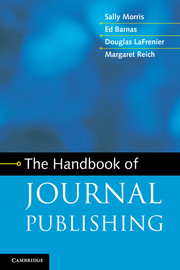Book contents
- Frontmatter
- Contents
- Preface and acknowledgments
- 1 Introduction to journals
- 2 Managing journals
- 3 Editing
- 4 The production process
- 5 Journal metrics
- 6 Marketing and sales
- 7 Fulfillment
- 8 Journal finances
- 9 Subsidiary income
- 10 Contract publishing
- 11 Copyright and other legal aspects
- 12 Ethical issues
- 13 The future of scholarly communication
- Appendix 1 Glossary
- Appendix 2 Resources
- Appendix 3 Vendors
- Index
- References
6 - Marketing and sales
Published online by Cambridge University Press: 05 March 2013
- Frontmatter
- Contents
- Preface and acknowledgments
- 1 Introduction to journals
- 2 Managing journals
- 3 Editing
- 4 The production process
- 5 Journal metrics
- 6 Marketing and sales
- 7 Fulfillment
- 8 Journal finances
- 9 Subsidiary income
- 10 Contract publishing
- 11 Copyright and other legal aspects
- 12 Ethical issues
- 13 The future of scholarly communication
- Appendix 1 Glossary
- Appendix 2 Resources
- Appendix 3 Vendors
- Index
- References
Summary
Introduction
One might think that “everybody knows the important journals in their field,” but marketing is an absolutely crucial function in journal publishing – not only for the publisher but for the author, reader, and buyer (the librarian) as well. “Marketing” entails a wide range of activities well beyond what the “marketing department” does, and requires support from editorial, fulfillment, production, technology, and accounting departments.
When a product manager emails authors about a new feature in an online journal; when an editor conducts a workshop for young scholars on how to get published in a journal; when a customer-service representative helps restore access to an IP range that had been shut off; when the IT group sends metadata to a library search engine; when an indexer lists keywords for the article abstract; when a programmer optimizes a web page for better search engine results – they are all helping to market the journal. This chapter discusses marketing in this broadest sense: an interrelated set of activities that promotes the brand (of the journal and the publisher) while maximizing the discoverability of each individual article.
“Brand” refers to the “identity” of a product, service, or company in the eyes of its customers – or the identity that the company would like the customer to perceive. In the journal world, the publisher’s brand matters to the Editors-in-Chief who are recruited to manage a journal, but the brand known to authors is almost always that of the journal rather than the publishing company. The reputations of the Editor-in-Chief and Editorial Board are an integral part of that brand for most authors.
- Type
- Chapter
- Information
- The Handbook of Journal Publishing , pp. 156 - 198Publisher: Cambridge University PressPrint publication year: 2013



